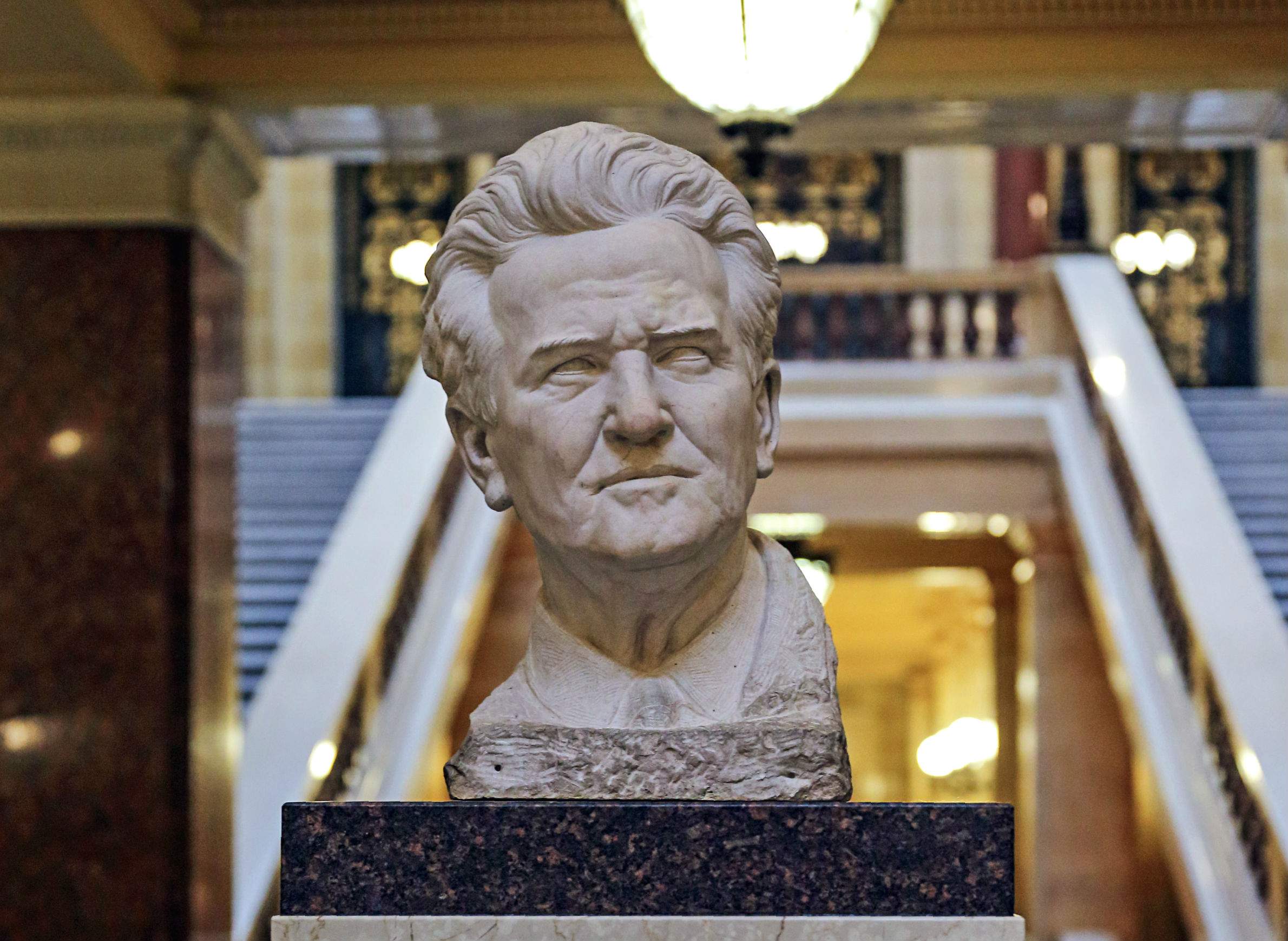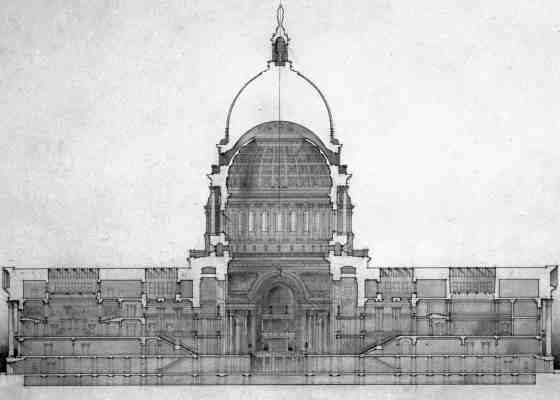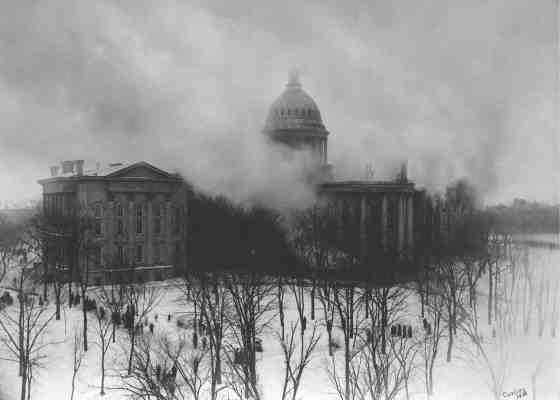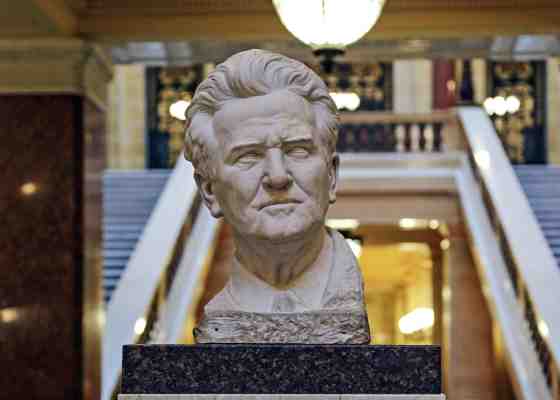
A Century Of Vigorous Debate In The Wisconsin Capitol

The polarized nature of politics in Wisconsin is not a new development, and intense debate has been a common aspect of life in the state capitol building going back to its opening in 1917.
At the time of the 1904 that destroyed the previous capitol building and during the construction of its replacement, fierce political combat was being waged in the state, explained Michael Edmonds, the director of programs and outreach at the Wisconsin Historical Society, in an Oct. 3, 2017 presentation about people who have influenced the state's politics since the capitol's construction. His talk at the Wisconsin Historical Museum was recorded for Wisconsin Public Television's University Place.
"There was a great battle going in Wisconsin politics between people who were calling themselves progressives and people who were calling themselves stalwarts," he said.
It was during the time of the Capitol fire that the famed progressive politician Robert La Follette Sr., known as "Fighting Bob," served as Wisconsin's governor. In office from 1901 to 1906. the Republican leader succeeded in advancing his legislative priorities, which included replacing the state’s caucus process with direct primaries to select candidates and ending the normalization of outright vote buying and bribery. As exemplified by La Follette, the rise of progressive Republicans influenced the policies of the state, and entire nation, for decades.
When a new Wisconsin Capitol building was completed in 1917, its opening was met with little fanfare. The nation had just entered World War I, and both pro-war and anti-German sentiment was on the rise. La Follette, by this time a U.S. senator, was censured in Wisconsin and Washington D.C. for expressing his belief that the war was being fought so that arms manufacturers could profit from it.
"La Follette's political career was nearly ruined by attacks from his pro-war rivals," Edmonds said. "It was so bad that federal officials called Wisconsin the traitor state."
By the 1930s, the progressive movement had splintered from the Republican Party. After World War II, the modern Democratic Party gained a foothold for the first time, and dominated politics in the state during the '50s and '60s. Since that time, control of the Capitol has since oscillated between Republicans and Democrats. Whoever is in power, though, Wisconsin has continued to influence national policy, including in the first decades of the 21st century.
"The Capitol dome has always been big enough to shelter a broad spectrum of conflicting opinions," Edmonds said. "It can surely continue to accommodate a civilized sifting and winnowing of solutions to problems from both sides of every divide for years to come."
Key Facts
- Robert La Follette, Sr. began calling for direct primary elections in 1897 to replace the state's corrupt electoral system, wherein a small number of powerful party officials chose candidates in secret. La Follette's proposal was blocked for several years until 1903, when the governor's progressive allies gained control of the state legislature. In the summer of 1904, La Follette hired University of Wisconsin football players to prevent anyone without proper credentials from entering the state Republican convention after learning of his opponents plan to pack the event and regain control. His primary reforms passed by referendum in the November 1904 election. This new system was first used in the 1906 gubernatorial race, when La Follette's preferred candidate, Irvine Lenroot, lost the Republican Party nomination to acting Governor James Davidson.
- With more than 122,000 soldiers from Wisconsin fighting in Europe during World War I, women across the state mobilized to support the effort and combat the 1918 influenza pandemic that would claim many lives. Their contributions during this time, as well as the organizational experience they gained, played a role in the fight for women to win the nationwide right to vote in 1919. In 1921, La Follette's wife Belle and Anna Blaine, the wife of then-Governor John Blaine, successfully campaigned for a law guaranteeing women rights equal to those of men. Wisconsin remains the only state to pass such a law.
- Facing widespread job loss as a result of the Great Depression, Wisconsin officials passed the nation's first unemployment compensation law in 1932. While the proposal predated the First World War, it eventually gained broad support from across the political spectrum in the face of the Depression.
- After the failure of many Wisconsin banks in March 1933, then-Governor Philip La Follette, Robert's son, closed them all for two weeks. The state saw widespread unrest that spring, including an increase in strikes in Milwaukee and violence in rural areas as dairy farmers sought to disrupt milk delivery due to low market prices.
- Samuel Pierce, the son of former slaves, fled the Jim Crow laws of the south and moved to Wisconsin. In 1925, he started working as a secretary and messenger for governors John Blaine, Fred Zimmerman, Walter Kohler, Philip La Follette and Albert Schmedeman. Known in the Capitol for his charm, Pierce was also a champion of African Americans in Madison, fighting against de facto segregation in public housing and lobbying for a community center to offer adult education classes. Upon his death in 1936, all five governors wrote tributes to the man who served as a public face for their office for two decades.
Key Quotes
- On the genesis of the Wisconsin Idea: "The progressive Republicans thought that one way to make government serve the people was to have professionals draft the legislation. Up until then lobbyists or legislators themselves, who were not necessarily well-informed, or well-educated would draft bills and vote on them. But the progressive idea was that there should be something called the Legislative Reference Bureau… they hired this fellow Charles McCarthy to run it. McCarthy's idea was that the ill-equipped lawmakers should have ready access to reliable facts and university-trained experts. He intended that the people of Wisconsin should be governed by laws drafted in their interest through a well-informed, carefully reasoned and nonpartisan process. This became known as the 'Wisconsin Idea' after McCarthy published a book with that title in 1912."
- On the development of progressive reforms in the state: "We associate the name La Follette with progressivism because he's best known, but in fact many of the reforms that were carried out during the Progressive Era were actually enacted when Francis McGovern was governor slightly later… The classic progressive laws provided for direct primaries, safer factories, workers' compensation, regulation of big corporations. They limited the working hours for women and children, set up state parks, and set up environmental conservation. They funded public libraries, public health services, and formed the University of Wisconsin-Extension. And these were all bills… that McGovern championed."
- On the election of Wisconsin's earliest women legislators in the 1920s: "The first female legislators at the Capitol were … all from rural Wisconsin. No Madison nor Milwaukee liberals here. Mildred Barber of Marathon County, Helen Brooks of Waushara County and Helen Thompson of Price County... Since that time there have always been women under the Capitol dome as lawmakers. Most of the time there was one, or two. It's only after the 1970's that we begin to get anything like proportional representation by gender, which of course, we're not even close to, yet."
- On the tradition of polarization in Wisconsin politics "We live in very polarized times today… But Wisconsin politics have always been polarized. The progressives and the stalwarts… had nothing good to say about each other. During the Vietnam era pro- and anti-war lawmakers opposed each other in the aisles. [Sen. Joseph] McCarthy, anti-communist crusaders in the early 50s had their opponents across the aisle. As far back as the Gilded Age, labor activists and captains of industry fought it out under the Capitol dome. … [W]hat sets today apart, even at the height of the McCarthy era, Republicans and Democrats worked amicably to solve Wisconsin's problems."






